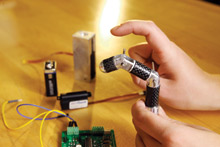
The hands of Sweet Briar student MaryAnne Haslow-Hall demonstrate the multiarticulating finger prototype that she helped invent. Photograph courtesy of Sweet Briar College.
The young women in the Wyllie Engineering Program at Sweet Briar College, Virginia, have no illusions about the difficulty of the task they have chosen-they say they intend to produce a prosthetic hand that “looks and performs like the real thing” and costs less than a thousand dollars to manufacture.
The engineering team led by faculty advisor Scott Pierce, PhD, hopes to create a multiarticulating hand that joins the benefits of function, cosmesis, and exceptional strength and durability to be suitable for amputees in developing nations. The hand will need to be reliable in harsh conditions and easy to fix if something does break. Additionally, the team is placing high priority on making a hand whose appearance doesn’t cause stigma. According to the college, several other undergraduate engineering programs nationwide have tried to meet similar criteria and had to scale back their objectives, but student Sarah Lightbody said that she and her teammates are aiming for nothing less.
“Another prosthetic hand that looks weird isn’t filling the niche,” said Lightbody, a junior engineering major who is designing the thumb for Sweet Briar’s prototype for her honors summer research project. “We have the attitude that we can do it-we just need to put our heads together and think about it.” Lightbody acknowledges that the project’s completion may be years away, but that’s acceptable to her.
Pierce, too, is taking the long view; a mechanical engineer by training, his industrial expertise in precision positioning led him to research interests in biomechanics and robotics. Last year, he and MaryAnne Haslow-Hall, then a Sweet Briar junior, were looking for a project. Haslow-Hall had just been involved in an award-winning class project to design tools that aid disabled workers at a light manufacturing plant in Lynchburg, Virginia.
“We both really enjoyed the feeling we got out of helping these people and decided we wanted to help others in some way,” Haslow-Hall recalled.
They settled on the hand after discussing alternatives and doing initial research, including investigating the Open Prosthetics Project. Sweet Briar researchers both use and contribute to the website, where innovators in prosthesis development freely share their designs and collaborate with funders and prosthesis users. Shoulders, arms, and hands are complex and present different technological and financial hurdles than lower-limb prostheses, Pierce noted.
“We can’t push the state-of-the-art technology, but maybe we can use existing technology to help more people,” Pierce said. This goal fits neatly with the philosophy of Sweet Briar’s engineering program, which is one of two such programs nationwide to reside in an all-women’s college. Solving problems in a global context is a point of emphasis, according to Sweet Briar.
With Pierce advising her, Haslow-Hall used her eight-week summer scholarship to review existing research and design the first phase of the hand, the index finger. Her work continued through independent study during the 2009-2010 academic year.
This summer, Lightbody and Lauren Perhala, an engineering and math double major also entering her junior year, were awarded scholarships to work with Pierce. While Lightbody is using computer modeling to design the thumb, Perhala is learning how to program a microcontroller that is part of the limb’s myoelectrics. Haslow-Hall calculated the force and torque necessary to simulate the action of the hand and found an actuator to meet the specifications. She built her finger prototype from carbon-fiber tubing and aluminum joints-all materials that are low-cost and available in the countries where the prosthetics will be used. Over the summer, Lightbody completed a computer model of the hand and began building and testing her thumb prototype.
She plans to continue the project through independent study, including working with Perhala on the myoelectrics. The students know they’ll have already graduated by the time a real person is fitted with the hand, but they measure success by the goals they set for themselves, Haslow-Hall said.
“I did way beyond what I had hoped for,” she said. “I came up with an idea, designed it on paper and 3D [computer] models, then I spent four months building a single finger. But the end of those four months was the happiest moment for me after a year’s worth of work. I finally got to see my finished design take shape in the world.”




